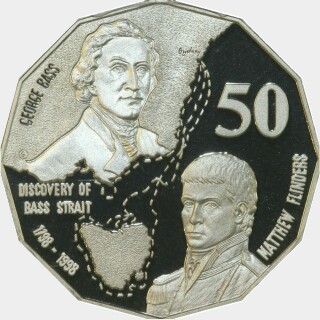



?
The Bass and Flinders fifty cent was issued in 1998 to commemorate 200 years since George Bass and Matthew Flinders proved
that Tasmania was an island by circumnavigating it. The
George Bass and Matthew Flinders will be remembered for their exploration of the Australian coastline. They were the last of the great explorers that mapped out the Australian Continent including the first to circumnavigate Tasmania, thus proving it was an island as they had suggested. The stretch of water between the Australian mainland and Tasmania was indeed named after George Bass. The Bass Strait will always remind Australians of his endeavour and achievements. The year of 1998 saw the 200th anniversary of the voyage around Tasmania. It was originally known as Van Diemens land but nobody thought it was an island until Bass and Flinders sailed the Norfolk around it (Australian History, 2013) . Unfortunately, this was the last time they sailed together as George Bass set sail for the Pacific and was never heard of or seen again along with the ship and its crew.
After the disappearance of his friend, Flinders returned to England whereupon he was asked to attempt an even bigger task. The British Government had asked him to circumnavigate Australia. His ship was the Investigator and he travelled to Australia and began the voyage starting from Sydney sailing north in 1802. The charts that he made during this voyage were amazingly accurate, so much so that they were used as reference for many years to come. By June 1803, he had returned to Sydney, thus proving that Australia was indeed just one island. Later in 1803, Flinders was captured on the French island of Mauritius and held prisoner for seven years. This was to be a harrowing experience for him and led to his decline in health. He did, however, write a book which was published on the same day as he died. The book was called A Voyage to Terra Australis.
Find out what dealers are paying with a subscription.
Subscribe now!Find out what coins have actually sold for and where with a Standard/Professional subscription.
Subscribe now!